Health Policy Advocacy Report: Childhood Vaccination Program Analysis
VerifiedAdded on 2022/10/01
|10
|2556
|334
Report
AI Summary
This report analyzes the childhood vaccination program as a health policy aimed at improving population health. It examines the policy's evidence-based design, background, and development, emphasizing its preventive measures against childhood diseases. The report highlights the opportunities for Registered Nurses (RNs) and Advanced Practice Registered Nurses (APRNs) in policymaking, including their professional knowledge and practical implementation roles. It also addresses the challenges associated with these opportunities and recommends strategies for effective advocacy and communication. Furthermore, the report includes interview question responses that delve into the specifics of a healthcare program, the target population, the nurse's role in program design, advocacy, and implementation, and the required healthcare teams. The report underscores the importance of RNs' involvement in health policy and program design to enhance healthcare outcomes. The report is contributed by a student and available on Desklib.
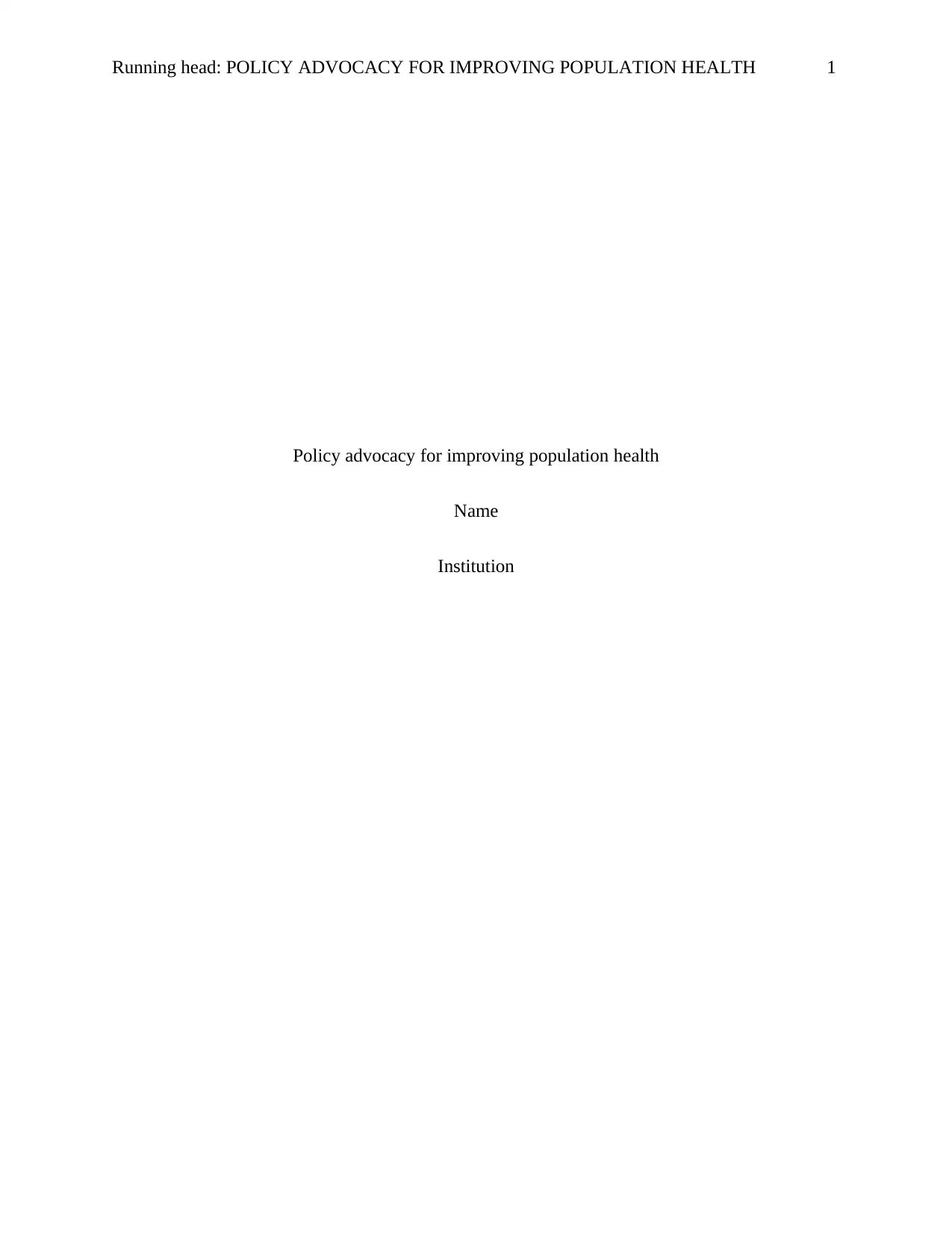
Running head: POLICY ADVOCACY FOR IMPROVING POPULATION HEALTH 1
Policy advocacy for improving population health
Name
Institution
Policy advocacy for improving population health
Name
Institution
Paraphrase This Document
Need a fresh take? Get an instant paraphrase of this document with our AI Paraphraser
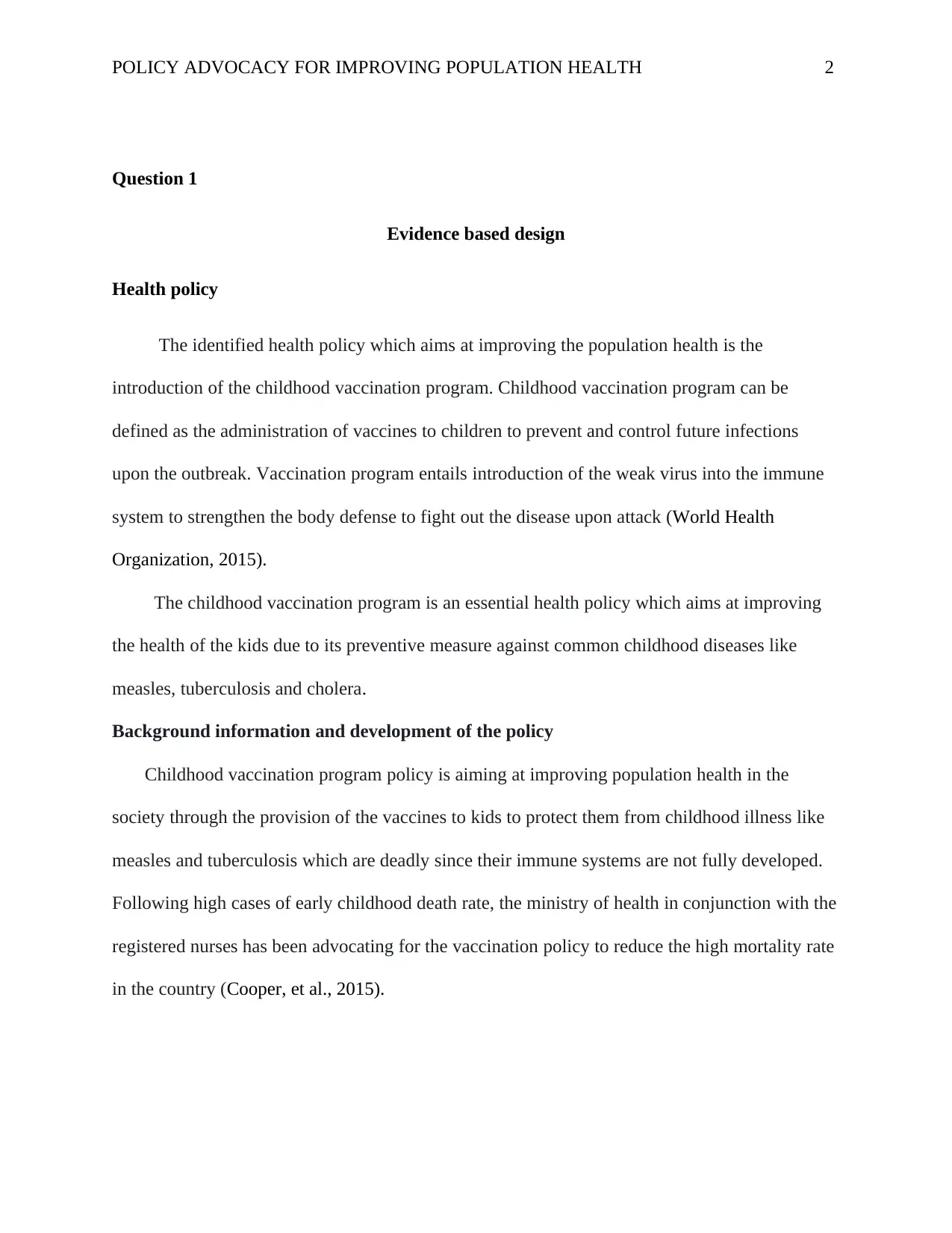
POLICY ADVOCACY FOR IMPROVING POPULATION HEALTH 2
Question 1
Evidence based design
Health policy
The identified health policy which aims at improving the population health is the
introduction of the childhood vaccination program. Childhood vaccination program can be
defined as the administration of vaccines to children to prevent and control future infections
upon the outbreak. Vaccination program entails introduction of the weak virus into the immune
system to strengthen the body defense to fight out the disease upon attack (World Health
Organization, 2015).
The childhood vaccination program is an essential health policy which aims at improving
the health of the kids due to its preventive measure against common childhood diseases like
measles, tuberculosis and cholera.
Background information and development of the policy
Childhood vaccination program policy is aiming at improving population health in the
society through the provision of the vaccines to kids to protect them from childhood illness like
measles and tuberculosis which are deadly since their immune systems are not fully developed.
Following high cases of early childhood death rate, the ministry of health in conjunction with the
registered nurses has been advocating for the vaccination policy to reduce the high mortality rate
in the country (Cooper, et al., 2015).
Question 1
Evidence based design
Health policy
The identified health policy which aims at improving the population health is the
introduction of the childhood vaccination program. Childhood vaccination program can be
defined as the administration of vaccines to children to prevent and control future infections
upon the outbreak. Vaccination program entails introduction of the weak virus into the immune
system to strengthen the body defense to fight out the disease upon attack (World Health
Organization, 2015).
The childhood vaccination program is an essential health policy which aims at improving
the health of the kids due to its preventive measure against common childhood diseases like
measles, tuberculosis and cholera.
Background information and development of the policy
Childhood vaccination program policy is aiming at improving population health in the
society through the provision of the vaccines to kids to protect them from childhood illness like
measles and tuberculosis which are deadly since their immune systems are not fully developed.
Following high cases of early childhood death rate, the ministry of health in conjunction with the
registered nurses has been advocating for the vaccination policy to reduce the high mortality rate
in the country (Cooper, et al., 2015).
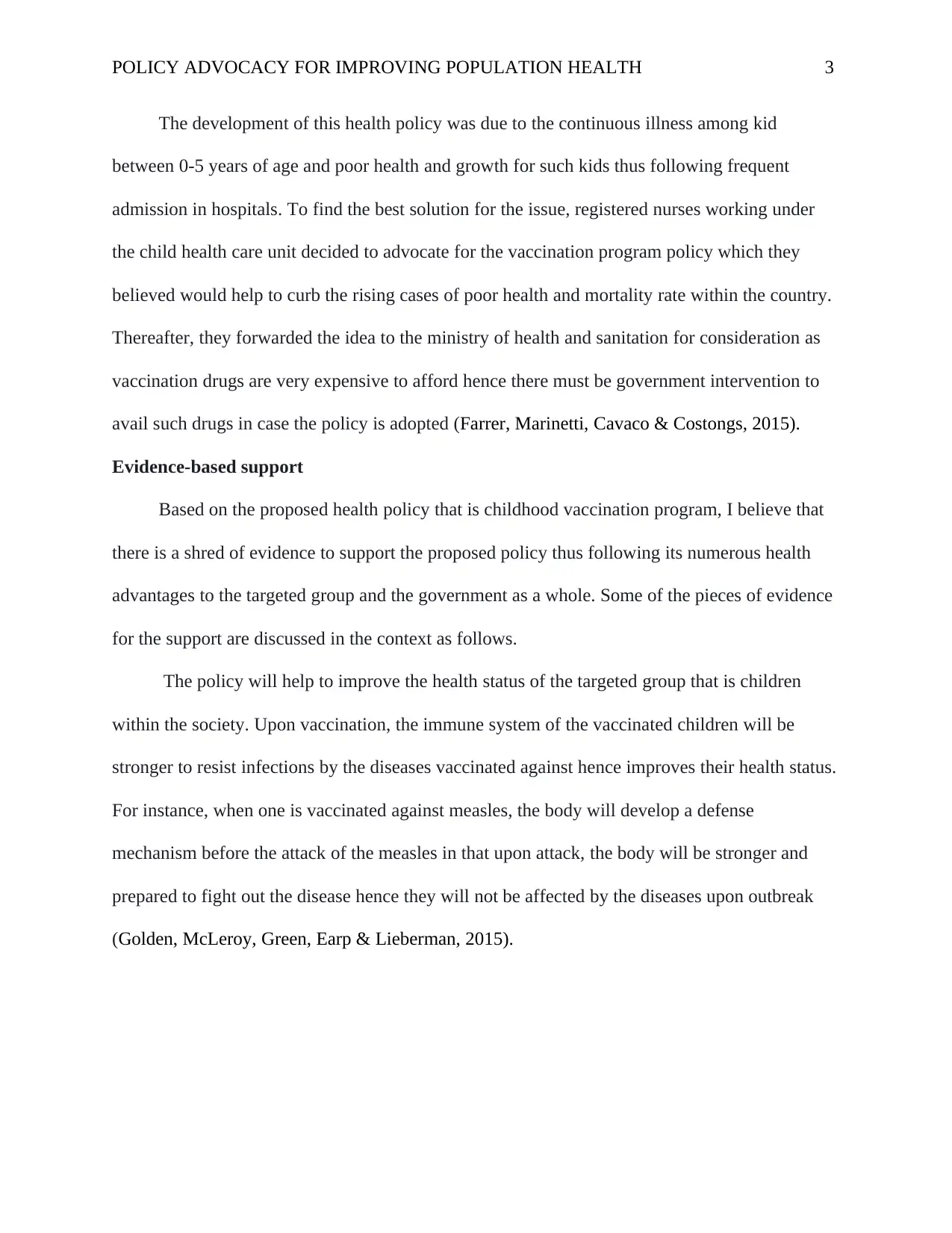
POLICY ADVOCACY FOR IMPROVING POPULATION HEALTH 3
The development of this health policy was due to the continuous illness among kid
between 0-5 years of age and poor health and growth for such kids thus following frequent
admission in hospitals. To find the best solution for the issue, registered nurses working under
the child health care unit decided to advocate for the vaccination program policy which they
believed would help to curb the rising cases of poor health and mortality rate within the country.
Thereafter, they forwarded the idea to the ministry of health and sanitation for consideration as
vaccination drugs are very expensive to afford hence there must be government intervention to
avail such drugs in case the policy is adopted (Farrer, Marinetti, Cavaco & Costongs, 2015).
Evidence-based support
Based on the proposed health policy that is childhood vaccination program, I believe that
there is a shred of evidence to support the proposed policy thus following its numerous health
advantages to the targeted group and the government as a whole. Some of the pieces of evidence
for the support are discussed in the context as follows.
The policy will help to improve the health status of the targeted group that is children
within the society. Upon vaccination, the immune system of the vaccinated children will be
stronger to resist infections by the diseases vaccinated against hence improves their health status.
For instance, when one is vaccinated against measles, the body will develop a defense
mechanism before the attack of the measles in that upon attack, the body will be stronger and
prepared to fight out the disease hence they will not be affected by the diseases upon outbreak
(Golden, McLeroy, Green, Earp & Lieberman, 2015).
The development of this health policy was due to the continuous illness among kid
between 0-5 years of age and poor health and growth for such kids thus following frequent
admission in hospitals. To find the best solution for the issue, registered nurses working under
the child health care unit decided to advocate for the vaccination program policy which they
believed would help to curb the rising cases of poor health and mortality rate within the country.
Thereafter, they forwarded the idea to the ministry of health and sanitation for consideration as
vaccination drugs are very expensive to afford hence there must be government intervention to
avail such drugs in case the policy is adopted (Farrer, Marinetti, Cavaco & Costongs, 2015).
Evidence-based support
Based on the proposed health policy that is childhood vaccination program, I believe that
there is a shred of evidence to support the proposed policy thus following its numerous health
advantages to the targeted group and the government as a whole. Some of the pieces of evidence
for the support are discussed in the context as follows.
The policy will help to improve the health status of the targeted group that is children
within the society. Upon vaccination, the immune system of the vaccinated children will be
stronger to resist infections by the diseases vaccinated against hence improves their health status.
For instance, when one is vaccinated against measles, the body will develop a defense
mechanism before the attack of the measles in that upon attack, the body will be stronger and
prepared to fight out the disease hence they will not be affected by the diseases upon outbreak
(Golden, McLeroy, Green, Earp & Lieberman, 2015).
⊘ This is a preview!⊘
Do you want full access?
Subscribe today to unlock all pages.

Trusted by 1+ million students worldwide
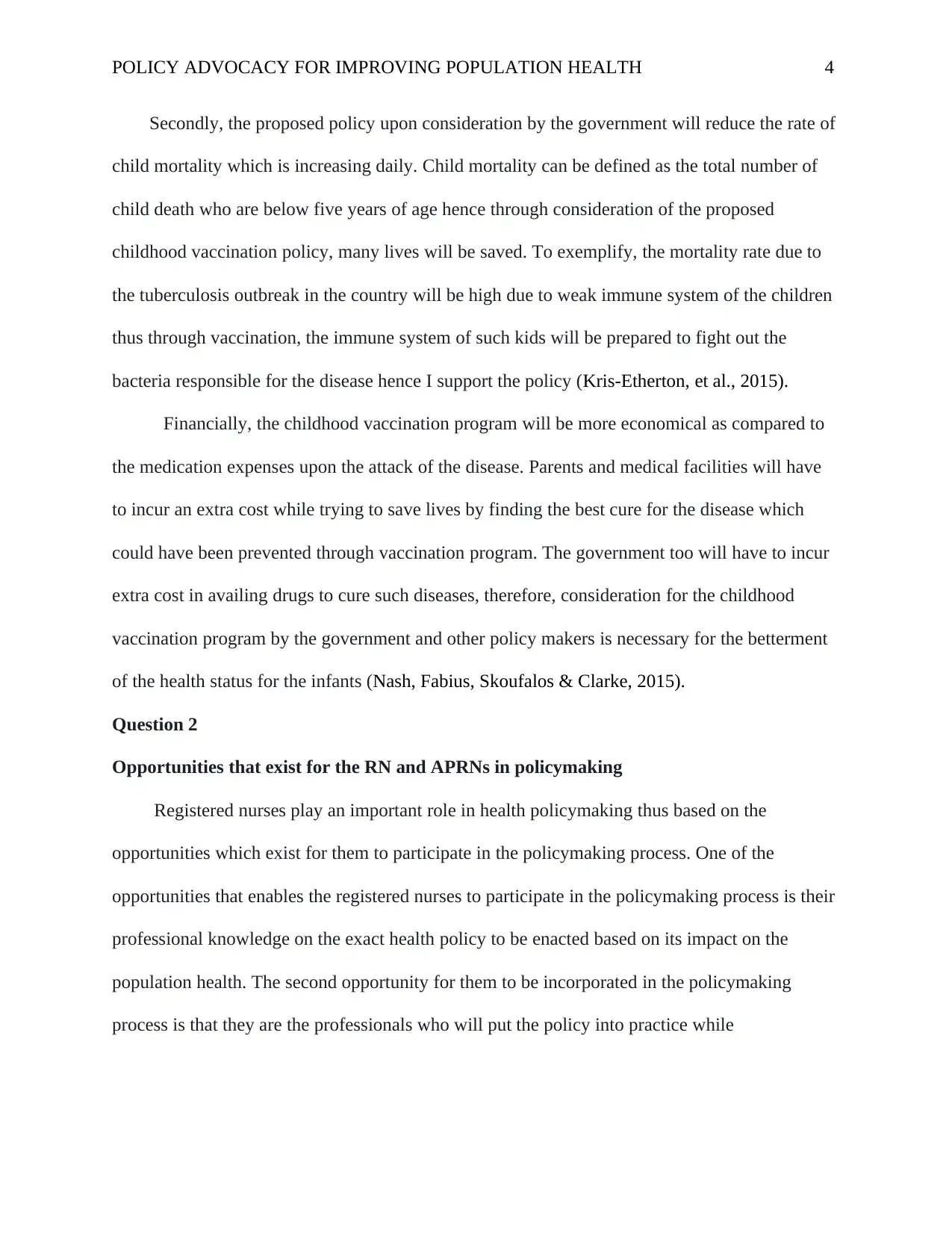
POLICY ADVOCACY FOR IMPROVING POPULATION HEALTH 4
Secondly, the proposed policy upon consideration by the government will reduce the rate of
child mortality which is increasing daily. Child mortality can be defined as the total number of
child death who are below five years of age hence through consideration of the proposed
childhood vaccination policy, many lives will be saved. To exemplify, the mortality rate due to
the tuberculosis outbreak in the country will be high due to weak immune system of the children
thus through vaccination, the immune system of such kids will be prepared to fight out the
bacteria responsible for the disease hence I support the policy (Kris-Etherton, et al., 2015).
Financially, the childhood vaccination program will be more economical as compared to
the medication expenses upon the attack of the disease. Parents and medical facilities will have
to incur an extra cost while trying to save lives by finding the best cure for the disease which
could have been prevented through vaccination program. The government too will have to incur
extra cost in availing drugs to cure such diseases, therefore, consideration for the childhood
vaccination program by the government and other policy makers is necessary for the betterment
of the health status for the infants (Nash, Fabius, Skoufalos & Clarke, 2015).
Question 2
Opportunities that exist for the RN and APRNs in policymaking
Registered nurses play an important role in health policymaking thus based on the
opportunities which exist for them to participate in the policymaking process. One of the
opportunities that enables the registered nurses to participate in the policymaking process is their
professional knowledge on the exact health policy to be enacted based on its impact on the
population health. The second opportunity for them to be incorporated in the policymaking
process is that they are the professionals who will put the policy into practice while
Secondly, the proposed policy upon consideration by the government will reduce the rate of
child mortality which is increasing daily. Child mortality can be defined as the total number of
child death who are below five years of age hence through consideration of the proposed
childhood vaccination policy, many lives will be saved. To exemplify, the mortality rate due to
the tuberculosis outbreak in the country will be high due to weak immune system of the children
thus through vaccination, the immune system of such kids will be prepared to fight out the
bacteria responsible for the disease hence I support the policy (Kris-Etherton, et al., 2015).
Financially, the childhood vaccination program will be more economical as compared to
the medication expenses upon the attack of the disease. Parents and medical facilities will have
to incur an extra cost while trying to save lives by finding the best cure for the disease which
could have been prevented through vaccination program. The government too will have to incur
extra cost in availing drugs to cure such diseases, therefore, consideration for the childhood
vaccination program by the government and other policy makers is necessary for the betterment
of the health status for the infants (Nash, Fabius, Skoufalos & Clarke, 2015).
Question 2
Opportunities that exist for the RN and APRNs in policymaking
Registered nurses play an important role in health policymaking thus based on the
opportunities which exist for them to participate in the policymaking process. One of the
opportunities that enables the registered nurses to participate in the policymaking process is their
professional knowledge on the exact health policy to be enacted based on its impact on the
population health. The second opportunity for them to be incorporated in the policymaking
process is that they are the professionals who will put the policy into practice while
Paraphrase This Document
Need a fresh take? Get an instant paraphrase of this document with our AI Paraphraser
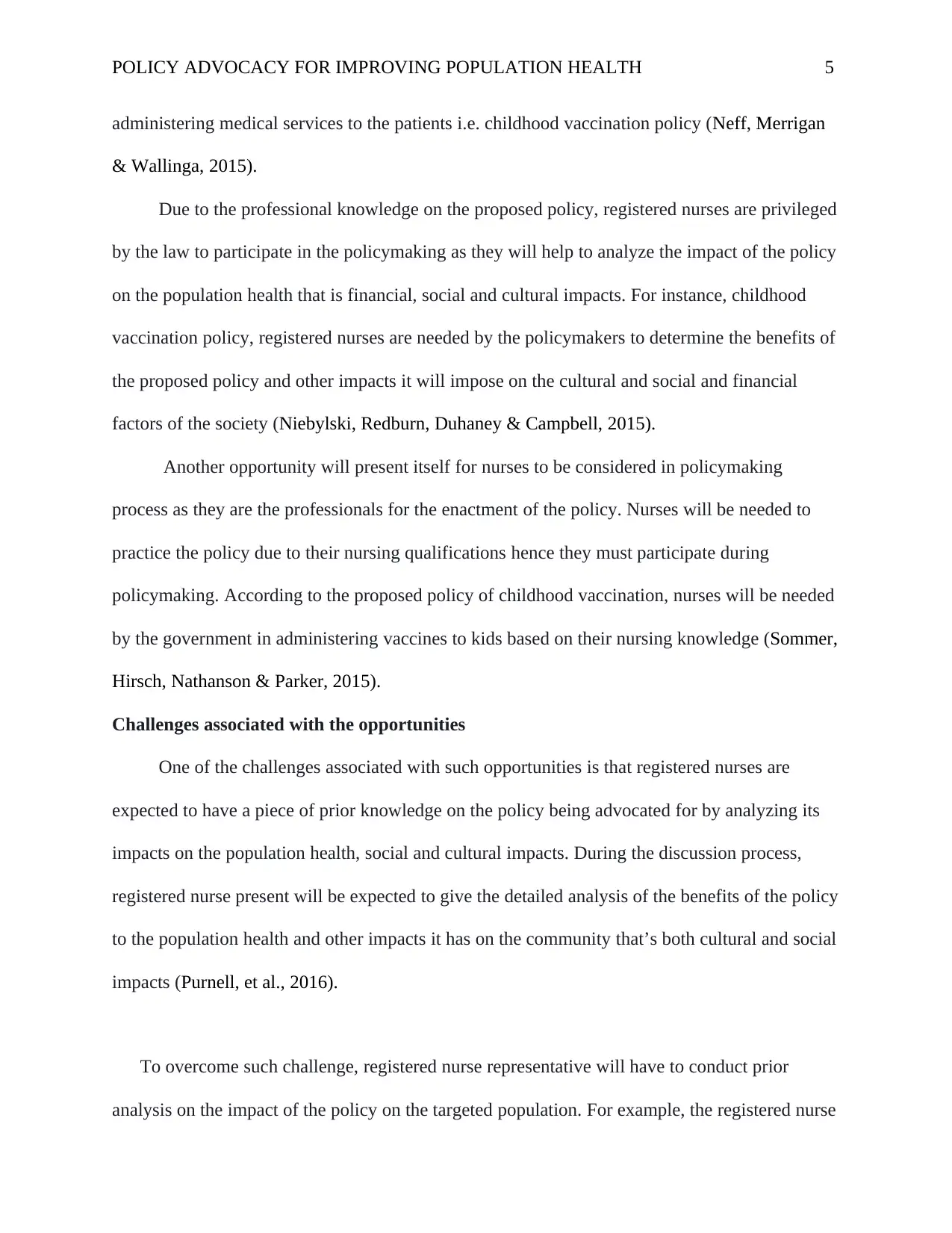
POLICY ADVOCACY FOR IMPROVING POPULATION HEALTH 5
administering medical services to the patients i.e. childhood vaccination policy (Neff, Merrigan
& Wallinga, 2015).
Due to the professional knowledge on the proposed policy, registered nurses are privileged
by the law to participate in the policymaking as they will help to analyze the impact of the policy
on the population health that is financial, social and cultural impacts. For instance, childhood
vaccination policy, registered nurses are needed by the policymakers to determine the benefits of
the proposed policy and other impacts it will impose on the cultural and social and financial
factors of the society (Niebylski, Redburn, Duhaney & Campbell, 2015).
Another opportunity will present itself for nurses to be considered in policymaking
process as they are the professionals for the enactment of the policy. Nurses will be needed to
practice the policy due to their nursing qualifications hence they must participate during
policymaking. According to the proposed policy of childhood vaccination, nurses will be needed
by the government in administering vaccines to kids based on their nursing knowledge (Sommer,
Hirsch, Nathanson & Parker, 2015).
Challenges associated with the opportunities
One of the challenges associated with such opportunities is that registered nurses are
expected to have a piece of prior knowledge on the policy being advocated for by analyzing its
impacts on the population health, social and cultural impacts. During the discussion process,
registered nurse present will be expected to give the detailed analysis of the benefits of the policy
to the population health and other impacts it has on the community that’s both cultural and social
impacts (Purnell, et al., 2016).
To overcome such challenge, registered nurse representative will have to conduct prior
analysis on the impact of the policy on the targeted population. For example, the registered nurse
administering medical services to the patients i.e. childhood vaccination policy (Neff, Merrigan
& Wallinga, 2015).
Due to the professional knowledge on the proposed policy, registered nurses are privileged
by the law to participate in the policymaking as they will help to analyze the impact of the policy
on the population health that is financial, social and cultural impacts. For instance, childhood
vaccination policy, registered nurses are needed by the policymakers to determine the benefits of
the proposed policy and other impacts it will impose on the cultural and social and financial
factors of the society (Niebylski, Redburn, Duhaney & Campbell, 2015).
Another opportunity will present itself for nurses to be considered in policymaking
process as they are the professionals for the enactment of the policy. Nurses will be needed to
practice the policy due to their nursing qualifications hence they must participate during
policymaking. According to the proposed policy of childhood vaccination, nurses will be needed
by the government in administering vaccines to kids based on their nursing knowledge (Sommer,
Hirsch, Nathanson & Parker, 2015).
Challenges associated with the opportunities
One of the challenges associated with such opportunities is that registered nurses are
expected to have a piece of prior knowledge on the policy being advocated for by analyzing its
impacts on the population health, social and cultural impacts. During the discussion process,
registered nurse present will be expected to give the detailed analysis of the benefits of the policy
to the population health and other impacts it has on the community that’s both cultural and social
impacts (Purnell, et al., 2016).
To overcome such challenge, registered nurse representative will have to conduct prior
analysis on the impact of the policy on the targeted population. For example, the registered nurse
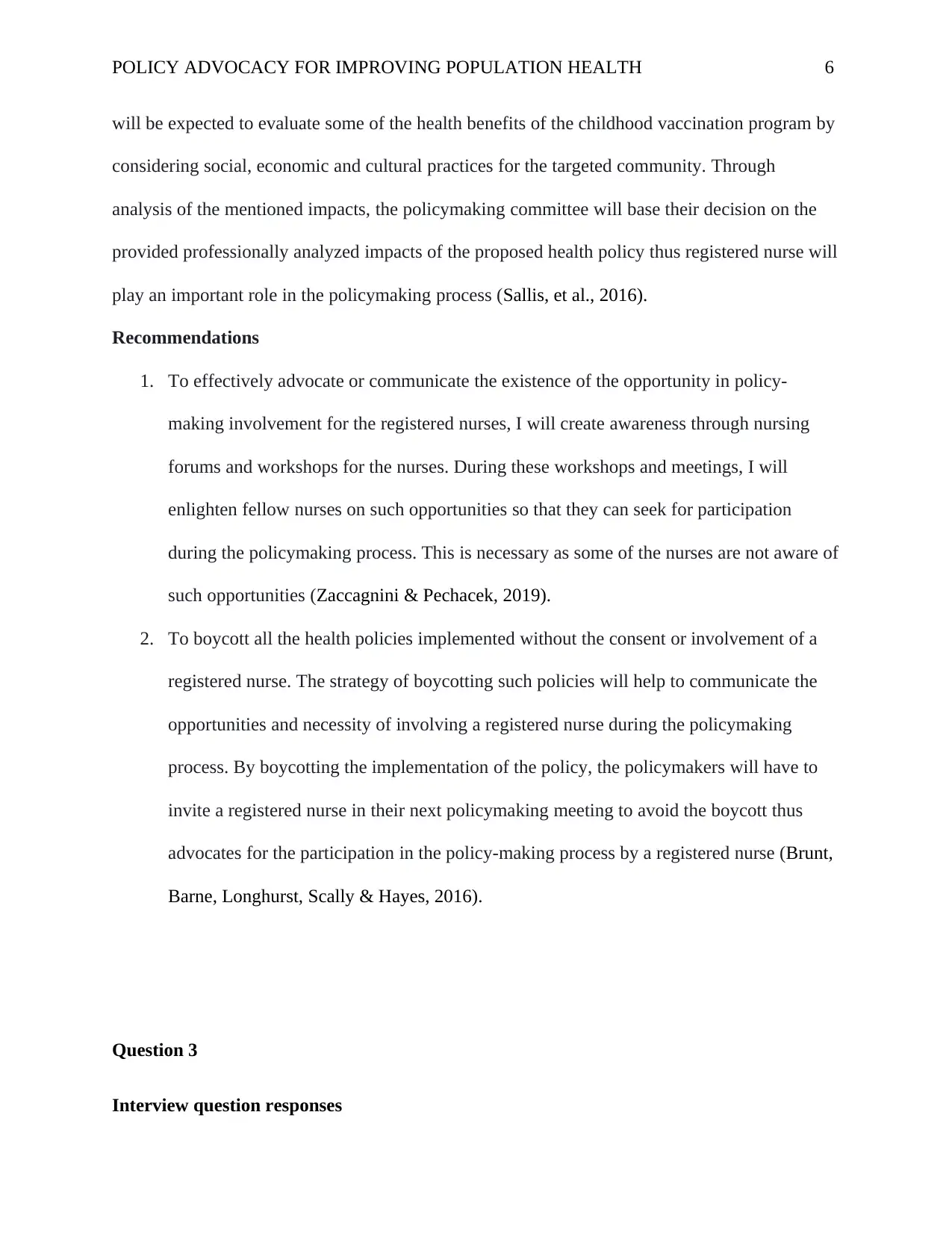
POLICY ADVOCACY FOR IMPROVING POPULATION HEALTH 6
will be expected to evaluate some of the health benefits of the childhood vaccination program by
considering social, economic and cultural practices for the targeted community. Through
analysis of the mentioned impacts, the policymaking committee will base their decision on the
provided professionally analyzed impacts of the proposed health policy thus registered nurse will
play an important role in the policymaking process (Sallis, et al., 2016).
Recommendations
1. To effectively advocate or communicate the existence of the opportunity in policy-
making involvement for the registered nurses, I will create awareness through nursing
forums and workshops for the nurses. During these workshops and meetings, I will
enlighten fellow nurses on such opportunities so that they can seek for participation
during the policymaking process. This is necessary as some of the nurses are not aware of
such opportunities (Zaccagnini & Pechacek, 2019).
2. To boycott all the health policies implemented without the consent or involvement of a
registered nurse. The strategy of boycotting such policies will help to communicate the
opportunities and necessity of involving a registered nurse during the policymaking
process. By boycotting the implementation of the policy, the policymakers will have to
invite a registered nurse in their next policymaking meeting to avoid the boycott thus
advocates for the participation in the policy-making process by a registered nurse (Brunt,
Barne, Longhurst, Scally & Hayes, 2016).
Question 3
Interview question responses
will be expected to evaluate some of the health benefits of the childhood vaccination program by
considering social, economic and cultural practices for the targeted community. Through
analysis of the mentioned impacts, the policymaking committee will base their decision on the
provided professionally analyzed impacts of the proposed health policy thus registered nurse will
play an important role in the policymaking process (Sallis, et al., 2016).
Recommendations
1. To effectively advocate or communicate the existence of the opportunity in policy-
making involvement for the registered nurses, I will create awareness through nursing
forums and workshops for the nurses. During these workshops and meetings, I will
enlighten fellow nurses on such opportunities so that they can seek for participation
during the policymaking process. This is necessary as some of the nurses are not aware of
such opportunities (Zaccagnini & Pechacek, 2019).
2. To boycott all the health policies implemented without the consent or involvement of a
registered nurse. The strategy of boycotting such policies will help to communicate the
opportunities and necessity of involving a registered nurse during the policymaking
process. By boycotting the implementation of the policy, the policymakers will have to
invite a registered nurse in their next policymaking meeting to avoid the boycott thus
advocates for the participation in the policy-making process by a registered nurse (Brunt,
Barne, Longhurst, Scally & Hayes, 2016).
Question 3
Interview question responses
⊘ This is a preview!⊘
Do you want full access?
Subscribe today to unlock all pages.

Trusted by 1+ million students worldwide
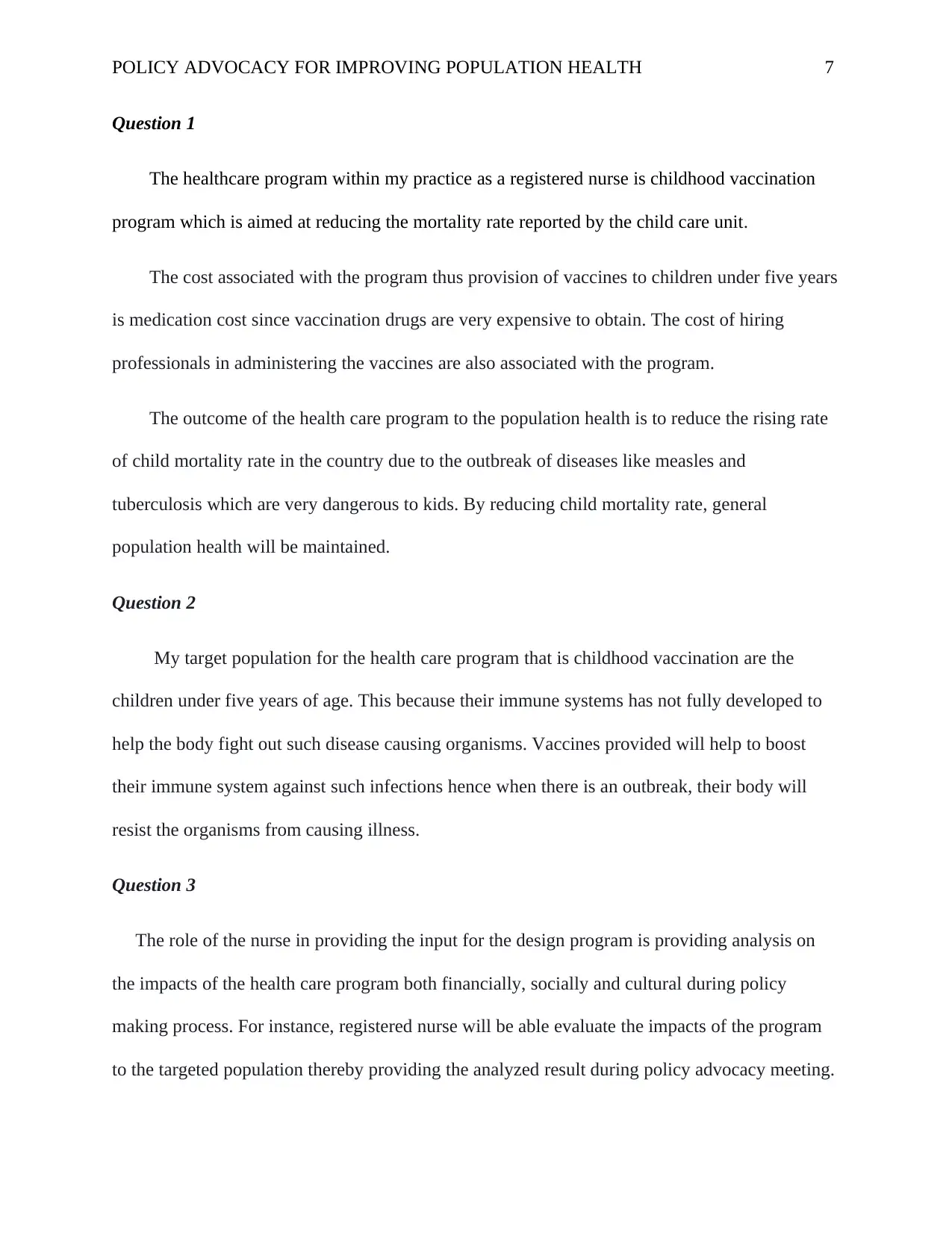
POLICY ADVOCACY FOR IMPROVING POPULATION HEALTH 7
Question 1
The healthcare program within my practice as a registered nurse is childhood vaccination
program which is aimed at reducing the mortality rate reported by the child care unit.
The cost associated with the program thus provision of vaccines to children under five years
is medication cost since vaccination drugs are very expensive to obtain. The cost of hiring
professionals in administering the vaccines are also associated with the program.
The outcome of the health care program to the population health is to reduce the rising rate
of child mortality rate in the country due to the outbreak of diseases like measles and
tuberculosis which are very dangerous to kids. By reducing child mortality rate, general
population health will be maintained.
Question 2
My target population for the health care program that is childhood vaccination are the
children under five years of age. This because their immune systems has not fully developed to
help the body fight out such disease causing organisms. Vaccines provided will help to boost
their immune system against such infections hence when there is an outbreak, their body will
resist the organisms from causing illness.
Question 3
The role of the nurse in providing the input for the design program is providing analysis on
the impacts of the health care program both financially, socially and cultural during policy
making process. For instance, registered nurse will be able evaluate the impacts of the program
to the targeted population thereby providing the analyzed result during policy advocacy meeting.
Question 1
The healthcare program within my practice as a registered nurse is childhood vaccination
program which is aimed at reducing the mortality rate reported by the child care unit.
The cost associated with the program thus provision of vaccines to children under five years
is medication cost since vaccination drugs are very expensive to obtain. The cost of hiring
professionals in administering the vaccines are also associated with the program.
The outcome of the health care program to the population health is to reduce the rising rate
of child mortality rate in the country due to the outbreak of diseases like measles and
tuberculosis which are very dangerous to kids. By reducing child mortality rate, general
population health will be maintained.
Question 2
My target population for the health care program that is childhood vaccination are the
children under five years of age. This because their immune systems has not fully developed to
help the body fight out such disease causing organisms. Vaccines provided will help to boost
their immune system against such infections hence when there is an outbreak, their body will
resist the organisms from causing illness.
Question 3
The role of the nurse in providing the input for the design program is providing analysis on
the impacts of the health care program both financially, socially and cultural during policy
making process. For instance, registered nurse will be able evaluate the impacts of the program
to the targeted population thereby providing the analyzed result during policy advocacy meeting.
Paraphrase This Document
Need a fresh take? Get an instant paraphrase of this document with our AI Paraphraser
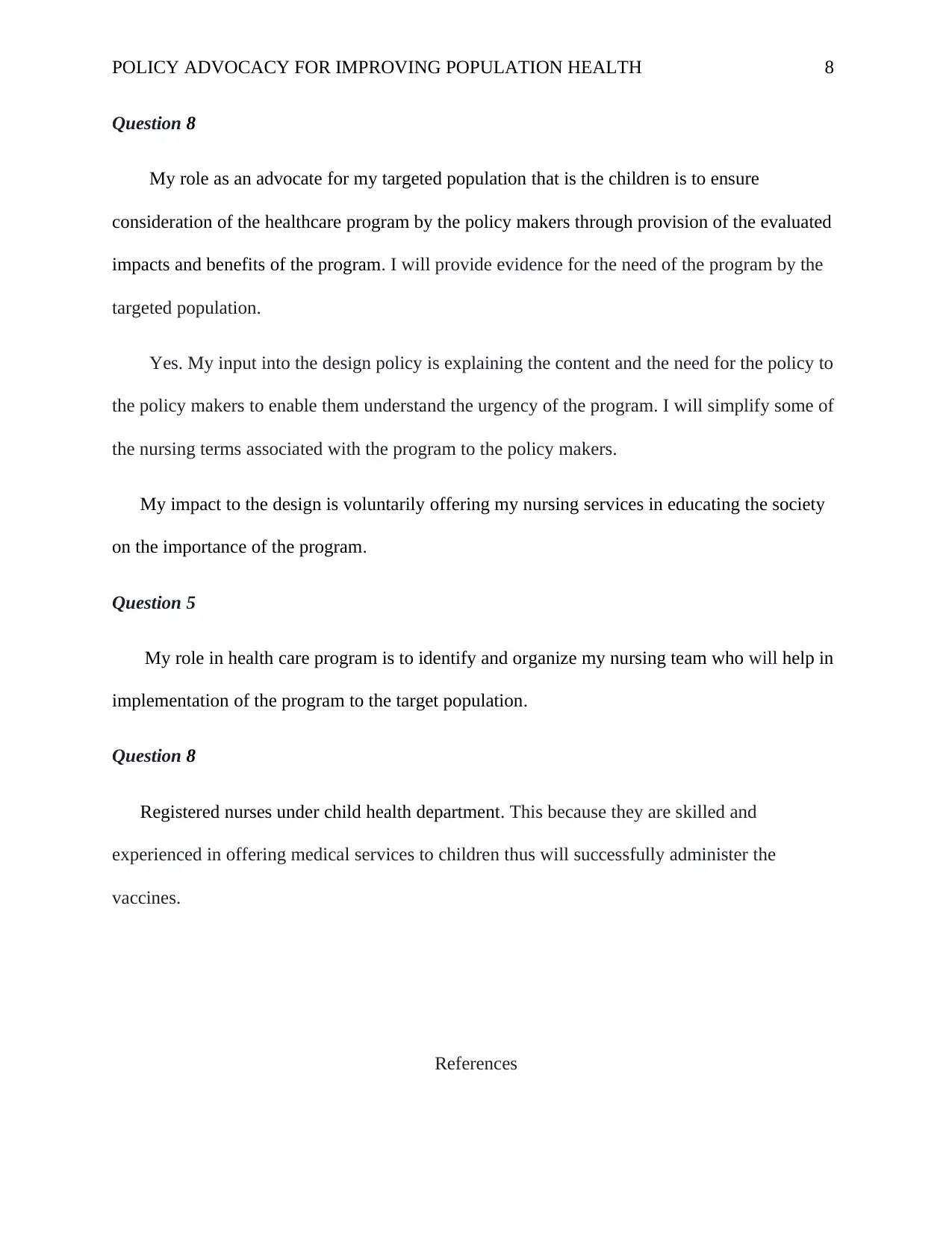
POLICY ADVOCACY FOR IMPROVING POPULATION HEALTH 8
Question 8
My role as an advocate for my targeted population that is the children is to ensure
consideration of the healthcare program by the policy makers through provision of the evaluated
impacts and benefits of the program. I will provide evidence for the need of the program by the
targeted population.
Yes. My input into the design policy is explaining the content and the need for the policy to
the policy makers to enable them understand the urgency of the program. I will simplify some of
the nursing terms associated with the program to the policy makers.
My impact to the design is voluntarily offering my nursing services in educating the society
on the importance of the program.
Question 5
My role in health care program is to identify and organize my nursing team who will help in
implementation of the program to the target population.
Question 8
Registered nurses under child health department. This because they are skilled and
experienced in offering medical services to children thus will successfully administer the
vaccines.
References
Question 8
My role as an advocate for my targeted population that is the children is to ensure
consideration of the healthcare program by the policy makers through provision of the evaluated
impacts and benefits of the program. I will provide evidence for the need of the program by the
targeted population.
Yes. My input into the design policy is explaining the content and the need for the policy to
the policy makers to enable them understand the urgency of the program. I will simplify some of
the nursing terms associated with the program to the policy makers.
My impact to the design is voluntarily offering my nursing services in educating the society
on the importance of the program.
Question 5
My role in health care program is to identify and organize my nursing team who will help in
implementation of the program to the target population.
Question 8
Registered nurses under child health department. This because they are skilled and
experienced in offering medical services to children thus will successfully administer the
vaccines.
References
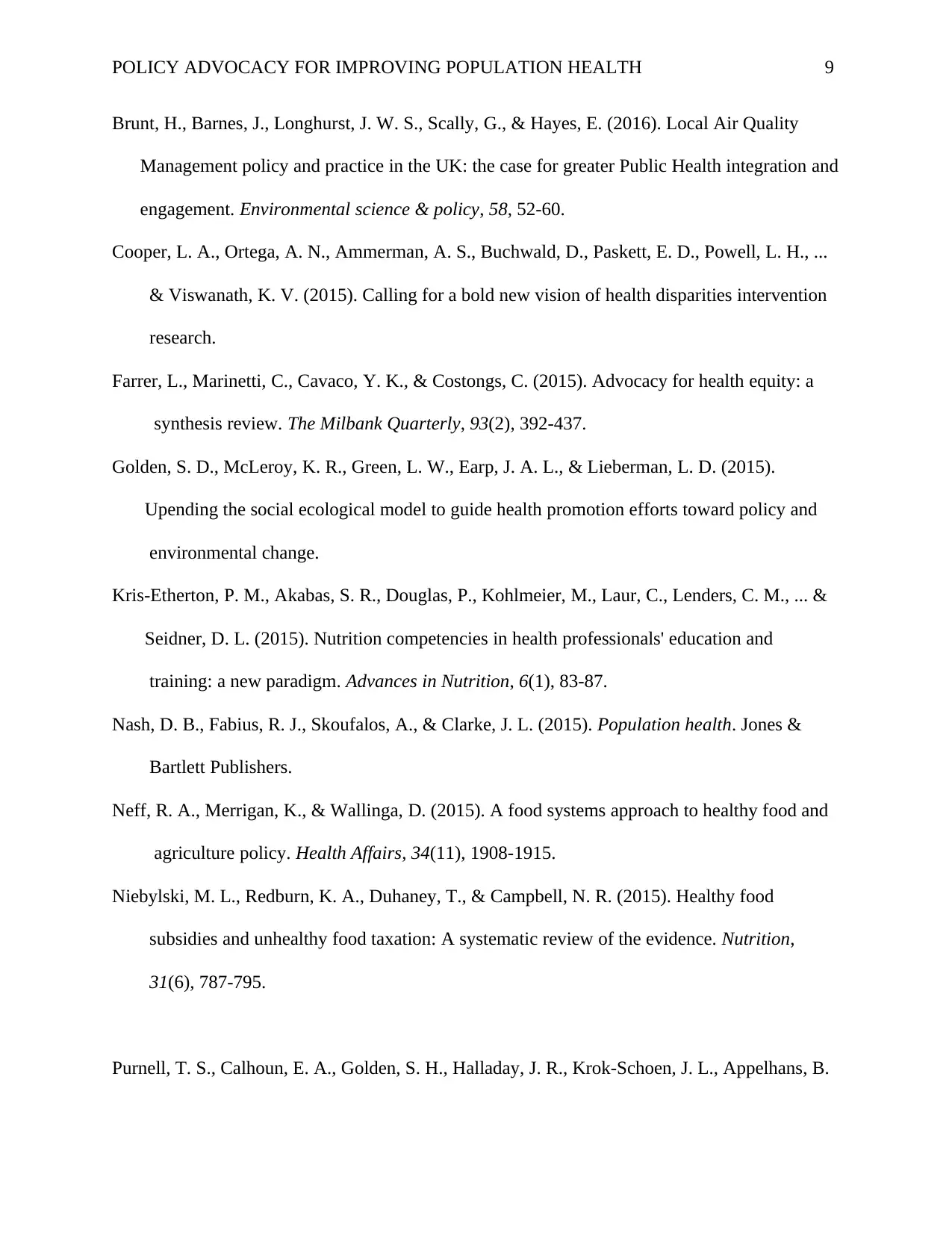
POLICY ADVOCACY FOR IMPROVING POPULATION HEALTH 9
Brunt, H., Barnes, J., Longhurst, J. W. S., Scally, G., & Hayes, E. (2016). Local Air Quality
Management policy and practice in the UK: the case for greater Public Health integration and
engagement. Environmental science & policy, 58, 52-60.
Cooper, L. A., Ortega, A. N., Ammerman, A. S., Buchwald, D., Paskett, E. D., Powell, L. H., ...
& Viswanath, K. V. (2015). Calling for a bold new vision of health disparities intervention
research.
Farrer, L., Marinetti, C., Cavaco, Y. K., & Costongs, C. (2015). Advocacy for health equity: a
synthesis review. The Milbank Quarterly, 93(2), 392-437.
Golden, S. D., McLeroy, K. R., Green, L. W., Earp, J. A. L., & Lieberman, L. D. (2015).
Upending the social ecological model to guide health promotion efforts toward policy and
environmental change.
Kris-Etherton, P. M., Akabas, S. R., Douglas, P., Kohlmeier, M., Laur, C., Lenders, C. M., ... &
Seidner, D. L. (2015). Nutrition competencies in health professionals' education and
training: a new paradigm. Advances in Nutrition, 6(1), 83-87.
Nash, D. B., Fabius, R. J., Skoufalos, A., & Clarke, J. L. (2015). Population health. Jones &
Bartlett Publishers.
Neff, R. A., Merrigan, K., & Wallinga, D. (2015). A food systems approach to healthy food and
agriculture policy. Health Affairs, 34(11), 1908-1915.
Niebylski, M. L., Redburn, K. A., Duhaney, T., & Campbell, N. R. (2015). Healthy food
subsidies and unhealthy food taxation: A systematic review of the evidence. Nutrition,
31(6), 787-795.
Purnell, T. S., Calhoun, E. A., Golden, S. H., Halladay, J. R., Krok-Schoen, J. L., Appelhans, B.
Brunt, H., Barnes, J., Longhurst, J. W. S., Scally, G., & Hayes, E. (2016). Local Air Quality
Management policy and practice in the UK: the case for greater Public Health integration and
engagement. Environmental science & policy, 58, 52-60.
Cooper, L. A., Ortega, A. N., Ammerman, A. S., Buchwald, D., Paskett, E. D., Powell, L. H., ...
& Viswanath, K. V. (2015). Calling for a bold new vision of health disparities intervention
research.
Farrer, L., Marinetti, C., Cavaco, Y. K., & Costongs, C. (2015). Advocacy for health equity: a
synthesis review. The Milbank Quarterly, 93(2), 392-437.
Golden, S. D., McLeroy, K. R., Green, L. W., Earp, J. A. L., & Lieberman, L. D. (2015).
Upending the social ecological model to guide health promotion efforts toward policy and
environmental change.
Kris-Etherton, P. M., Akabas, S. R., Douglas, P., Kohlmeier, M., Laur, C., Lenders, C. M., ... &
Seidner, D. L. (2015). Nutrition competencies in health professionals' education and
training: a new paradigm. Advances in Nutrition, 6(1), 83-87.
Nash, D. B., Fabius, R. J., Skoufalos, A., & Clarke, J. L. (2015). Population health. Jones &
Bartlett Publishers.
Neff, R. A., Merrigan, K., & Wallinga, D. (2015). A food systems approach to healthy food and
agriculture policy. Health Affairs, 34(11), 1908-1915.
Niebylski, M. L., Redburn, K. A., Duhaney, T., & Campbell, N. R. (2015). Healthy food
subsidies and unhealthy food taxation: A systematic review of the evidence. Nutrition,
31(6), 787-795.
Purnell, T. S., Calhoun, E. A., Golden, S. H., Halladay, J. R., Krok-Schoen, J. L., Appelhans, B.
⊘ This is a preview!⊘
Do you want full access?
Subscribe today to unlock all pages.

Trusted by 1+ million students worldwide
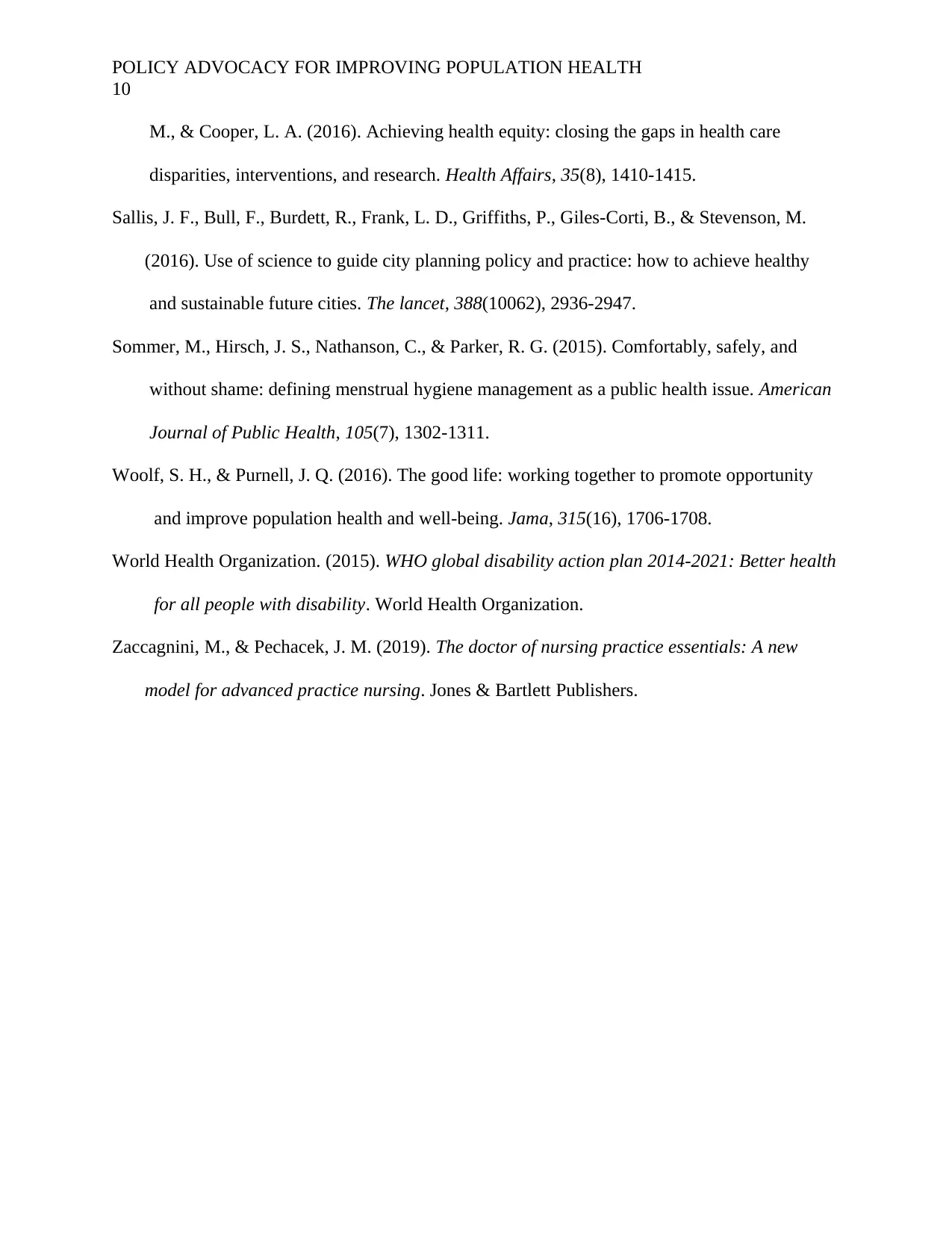
POLICY ADVOCACY FOR IMPROVING POPULATION HEALTH
10
M., & Cooper, L. A. (2016). Achieving health equity: closing the gaps in health care
disparities, interventions, and research. Health Affairs, 35(8), 1410-1415.
Sallis, J. F., Bull, F., Burdett, R., Frank, L. D., Griffiths, P., Giles-Corti, B., & Stevenson, M.
(2016). Use of science to guide city planning policy and practice: how to achieve healthy
and sustainable future cities. The lancet, 388(10062), 2936-2947.
Sommer, M., Hirsch, J. S., Nathanson, C., & Parker, R. G. (2015). Comfortably, safely, and
without shame: defining menstrual hygiene management as a public health issue. American
Journal of Public Health, 105(7), 1302-1311.
Woolf, S. H., & Purnell, J. Q. (2016). The good life: working together to promote opportunity
and improve population health and well-being. Jama, 315(16), 1706-1708.
World Health Organization. (2015). WHO global disability action plan 2014-2021: Better health
for all people with disability. World Health Organization.
Zaccagnini, M., & Pechacek, J. M. (2019). The doctor of nursing practice essentials: A new
model for advanced practice nursing. Jones & Bartlett Publishers.
10
M., & Cooper, L. A. (2016). Achieving health equity: closing the gaps in health care
disparities, interventions, and research. Health Affairs, 35(8), 1410-1415.
Sallis, J. F., Bull, F., Burdett, R., Frank, L. D., Griffiths, P., Giles-Corti, B., & Stevenson, M.
(2016). Use of science to guide city planning policy and practice: how to achieve healthy
and sustainable future cities. The lancet, 388(10062), 2936-2947.
Sommer, M., Hirsch, J. S., Nathanson, C., & Parker, R. G. (2015). Comfortably, safely, and
without shame: defining menstrual hygiene management as a public health issue. American
Journal of Public Health, 105(7), 1302-1311.
Woolf, S. H., & Purnell, J. Q. (2016). The good life: working together to promote opportunity
and improve population health and well-being. Jama, 315(16), 1706-1708.
World Health Organization. (2015). WHO global disability action plan 2014-2021: Better health
for all people with disability. World Health Organization.
Zaccagnini, M., & Pechacek, J. M. (2019). The doctor of nursing practice essentials: A new
model for advanced practice nursing. Jones & Bartlett Publishers.
1 out of 10
Related Documents
Your All-in-One AI-Powered Toolkit for Academic Success.
+13062052269
info@desklib.com
Available 24*7 on WhatsApp / Email
![[object Object]](/_next/static/media/star-bottom.7253800d.svg)
Unlock your academic potential
Copyright © 2020–2025 A2Z Services. All Rights Reserved. Developed and managed by ZUCOL.





